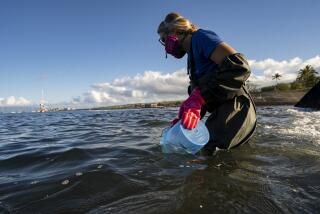TV Reviews : ‘Hawaii’: From Eden to Ecological Disaster
- Share via
The West in general--and Americans in particular--get off the hook far too easily for destroying Hawaii’s fragile ecosystems in “Hawaii: Strangers in Paradise,” the opening segment of “National Geographic’s” 1991-92 television season tonight (8 p.m. on KCET Channel 28 and KPBS Channel 15, 7 p.m. on KVCR Channel 24).
Narrated by F. Murray Abraham, the hourlong premiere traces the evolution of the island chain from its explosive volcanic beginnings 70 million years ago through its natural development of species, to its inhabitation by Polynesians in AD 100 and the catastrophic arrival of “Europeans” in 1778.
But then, without a hint of more modern examples that devastated the native ecology in the past 200 years, the program leaps to smog, polluted beaches and the small but noble efforts of four scientists trying to save the islands’ rare and endangered birds and plants.
A biologist searching for the rare o’o bird he last saw in 1981 in the Alaka’i rain forest in Kauai leaves more of a feeling of sadness at the loss rather than anger or outrage. More than 25% of the nation’s endangered birds and plants and 70% of all U.S. extinctions have taken place in Hawaii.
Producers Paul Atkins and Grace Nitska Atkins use minimal, occasionally corny dialogue with some startling footage, particularly scenes of red-orange soil eroding to the ocean as it chokes off sea life.
Near the hour’s end, at French Frigate Shoals northwest of the island chain, the Atkinses deliver an ironic statement: The only safe haven for species like the ancient green turtle and the Hawaiian monk seal remain on the tiny, desolate island uninhabited by humans.
More to Read
The complete guide to home viewing
Get Screen Gab for everything about the TV shows and streaming movies everyone’s talking about.
You may occasionally receive promotional content from the Los Angeles Times.






